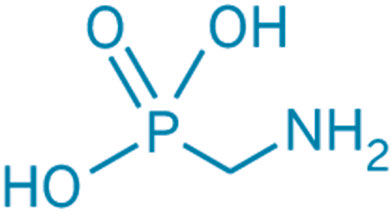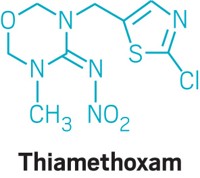Advertisement
Grab your lab coat. Let's get started
Welcome!
Welcome!
Create an account below to get 6 C&EN articles per month, receive newsletters and more - all free.
It seems this is your first time logging in online. Please enter the following information to continue.
As an ACS member you automatically get access to this site. All we need is few more details to create your reading experience.
Not you? Sign in with a different account.
Not you? Sign in with a different account.
ERROR 1
ERROR 1
ERROR 2
ERROR 2
ERROR 2
ERROR 2
ERROR 2
Password and Confirm password must match.
If you have an ACS member number, please enter it here so we can link this account to your membership. (optional)
ERROR 2
ACS values your privacy. By submitting your information, you are gaining access to C&EN and subscribing to our weekly newsletter. We use the information you provide to make your reading experience better, and we will never sell your data to third party members.
Food Science
Rocky Road For Roundup
Resistant weeds, fears of health effects drive market for alternatives to widely used herbicide
by Britt E. Erickson , Melody M. Bomgardner
September 21, 2015
| A version of this story appeared in
Volume 93, Issue 37

It didn’t take much convincing to get Mike Pietzyk to try a new weed-killing product on one of his cornfields in southeastern Nebraska. “The days of going out and spraying Roundup twice a year—those are long gone,” says Pietzyk, a second-generation grower who has farmed for 25 years.
Pietzyk says he’s had to use increasing amounts of the glyphosate herbicide during the past five years because weeds are developing resistance to it. Like many farmers, he has had to put older chemicals into his rotation, including 2,4-dichlorophenoxyacetic acid (2,4-D). And he isn’t happy about going back to that chemical, which dates to his father’s post-World War II generation. “I don’t know if I’ve been around it too much, but it will give me a headache if I smell it,” he says.
Glyphosate, the active ingredient in Roundup and its generic competitors, is losing its appeal to farmers and the general public. Not only are weeds becoming resistant to the chemical, but concerns about its health effects are growing. Regulators around the world have long considered glyphosate to be of low toxicity, but a controversial report released earlier this year by the World Health Organization raised questions and fears about whether governments have sufficiently evaluated this much-used chemical.
Controversial Classification
GLYPHOSATE AT A GLANCE

◾ Most common surfactant added to facilitate uptake of glyphosate by plants: polyethoxylated tallow amine

◾ Major metabolite of glyphosate: aminomethylphosphonic acid (AMPA)

◾ Number of countries that allow the use of glyphosate: >130
◾ Effective against the following: >100 annual broadleaf weeds and grasses, and >60 perennial weeds
◾ Number of glyphosate-resistant weed species documented in U.S. crop production areas: 15
SOURCES: IARC Monographs, Vol. 112; International Survey of Herbicide Resistant Weeds; and the U.S. Department of Agriculture
The report, released in March by WHO’s International Agency for Research on Cancer (IARC), classified glyphosate as a “probable carcinogen.” California was quick to follow suit, announcing earlier this month that it intends to add the herbicide to the state’s list of chemicals known to cause cancer.
The French government in June banned retailers from selling glyphosate-based herbicides to consumers because of concerns over health risks. And retailers in Germany began voluntarily pulling glyphosate products from their store shelves. The IARC report also prompted the government of Colombia to suspend the use of glyphosate in an antinarcotics aerial spraying program of coca plants.
Pesticide manufacturers are strongly disputing IARC’s classification of glyphosate, saying the agency failed to consider many important health studies. Monsanto, which built its business around Roundup and the genetically modified seeds that are resistant to it, points to a rigorous, four-year review of the risks of glyphosate, finalized in April, by the German Federal Institute for Risk Assessment. The review examined several studies that were not considered in the IARC assessment and concluded that glyphosate is “unlikely to pose a carcinogenic risk in humans.”
German officials conducted the review as part of the European Union’s ongoing reassessment of glyphosate. The report recommends that the EU carry out an extensive review of the IARC report as soon as possible and resolve any discrepancies between the IARC conclusions and the EU reassessment before it makes a decision.
The German report also urges the EU to closely examine the surfactants added to glyphosate herbicides. It cites “convincing evidence that the measured toxicity of some glyphosate-containing herbicides is the result of the coformulants in the plant protection products, such as tallow amines used as surfactants.”
In the U.S., the Environmental Protection Agency is working on its own reevaluation of the health and environmental risks posed by glyphosate. EPA last conducted such an assessment in 1993, concluding that there is no evidence of carcinogenicity and low toxicity. EPA also determined in 1994 that aminomethylphosphonic acid (AMPA), the major breakdown product of glyphosate, does not need to be regulated based on its low toxicity.
The U.S. and EU are both scheduled to complete their reassessments of glyphosate later this year, but they could be delayed to give regulators time to thoroughly review the IARC report. Monsanto is also conducting its own review of the controversial IARC report. The company hired the global firm Intertek Scientific & Regulatory Consultancy in July to convene an independent panel of experts to examine the report’s conclusions. Monsanto says it wants to reassure consumers that glyphosate products are safe.
Activists Heighten Fears
Meanwhile, a coalition of U.S. consumer activist groups is using the IARC classification to bolster a new campaign called Feed the World, which is aimed at banning glyphosate in the U.S. by the end of 2018.
The groups are opposed to genetically modified foods and the pesticides used on them, particularly glyphosate. They blame glyphosate for killing beneficial gut bacteria in people and farm animals, and for leading to a host of disorders, including attention deficit hyperactivity disorder, autism, Alzheimer’s disease, celiac disease and gluten intolerance, infertility, birth defects, and cancer.
Feed the World recently teamed up with the Organic Consumers Association, a group dedicated to preserving strict organic food standards, to offer a glyphosate testing service. For $119, consumers can get their water, urine, or breast milk tested for the presence of glyphosate. Consumers can request a sample collection cup and make payments on the website feedtheworld.info. Feed the World claims its service is the “first-ever validated glyphosate testing (LC/MS/MS) for the general public worldwide.” LC/MS/MS refers to high-performance liquid chromatography with tandem mass spectrometry—one of the analytical methods commonly used to detect glyphosate.

The group points out that more than 45% of the glyphosate used around the world in 2012 was applied to crops that are genetically modified to resist it. More than 90% of the soybeans and 85% of the corn grown in the U.S. in 2012 was genetically modified to tolerate glyphosate, according to the U.S. Department of Agriculture.
Monsanto commercialized the first Roundup Ready seeds—which are genetically modified to resist glyphosate—in 1996. At that time, glyphosate was used on about 25% of the soybeans and 4% of the corn grown in the U.S., primarily to clear weeds in fields before planting. With the introduction of Roundup Ready seeds, glyphosate usage skyrocketed because farmers could, for the first time, apply the herbicide after seedlings emerged.
Glyphosate usage in the U.S. increased from about 30 million lb in 1996 to more than 250 million lb in 2012, according to estimates by the U.S. Geological Survey.
“There certainly is no question that the advent of Roundup Ready crops has translated to a dramatic increase in glyphosate use and corresponding increase in environmental concentrations of glyphosate,” says Dana Kolpin, a USGS research hydrologist.
USGS scientists reported last year in the Journal of the American Water Resources Association that glyphosate and AMPA, the degradation product, are transported from agricultural fields and urban areas into the environment (DOI: 10.1111/jawr.12159). The study summarized results from 3,732 soil, sediment, and water samples collected from 2001 to 2010 in 38 states. Glyphosate was detected in more than half of the samples. AMPA was found more frequently than glyphosate, and both chemicals were detected more frequently during the second half of the study period than during the first half.
Even though glyphosate is widespread in the environment, Monsanto and other pesticide manufacturers maintain that it is safe. Glyphosate acts by inhibiting an enzyme in plants called 5-enolpyruvylshikimate-3-phosphate synthase (EPSPS), which is involved in the synthesis of essential amino acids needed for plant growth. Animals, including humans, do not have that enzyme.
“We are seeing reports of isolated decisions by local officials or retailers to restrict access to glyphosate, but these actions are largely occurring outside the established, science-based regulatory process,” Monsanto says. Biomonitoring data show that most individuals have no detectable glyphosate in their urine, the company says, adding that the public’s typical glyphosate intake is about 10,000 times as low as EPA’s allowable daily intake of the substance.
Monsanto is hoping to suppress the growing opposition to genetically modified foods and the pesticides used on them. “We recognize there is a lot of misinformation about who we are and what we do,” says Kelly Clauss, who leads Monsanto’s preparedness and engagement team.
Clauss and her group try to stop rumors online. For example, the company has launched a page on its website called Just Plain False. Some of the myths it has tried to debunk so far include the following: Monsanto is developing genetically modified marijuana, genetically modified foods are untested and unsafe, and Monsanto has undue influence on governments and independent researchers.
Rise of Resistant Weeds


While Monsanto and other pesticide manufacturers are trying to improve their image with the general public, farmers are struggling to find herbicides that work. They readily admit that years of heavily relying on a single solution to weed control—Monsanto’s Roundup Ready seed and glyphosate herbicide—has been a losing bet.
At least 15 species of weeds have developed resistance to glyphosate in the U.S., and resistant weeds are spreading around the world, according to the International Survey of Herbicide Resistant Weeds. Once an important weed-control tool, glyphosate is now unreliable, even for farmers who have never planted genetically modified crops.
When it was introduced, the Roundup Ready system was unbeatable. Glyphosate killed any weed, at any time, without harming crops. Farmers didn’t have to till fields to control weeds; they could just replant. And a little glyphosate knocked down even big weeds—a bit of the systemic herbicide on a leaf would kill the entire plant from the roots. The chemical is cheap and easy to use.
In Tennessee, where farmers grow corn, soybeans, and cotton, that system is no longer working, says Larry Steckel, weed specialist at the University of Tennessee, Knoxville.
Most of Steckel’s time is spent talking with farmers to help assess problem weeds, such as Palmer amaranth and mare’s tail. “Every one of my farmers is struggling with them and has been for at least six years,” Steckel observes. “They have had to adjust their practices or go out of business.”

The state’s rolling hills make tilling impossible in many places, Steckel says, but farmers who can, do. They rotate their crops and plant cover crops to shade out weeds. They are spending much more money on older herbicides because killing glyphosate-resistant weeds requires chemicals with multiple modes of action. And they employ much more labor. “Crews are out weeding by hand and chopping at weeds. That was unheard of six years ago,” Steckel says.
The fearsome Palmer amaranth, also called pigweed, is a prime example of what farmers and scientists are up against. The tall, heat-tolerant weed can grow 2 to 3 inches a day, Steckel says, and a female plant can produce up to half a million seeds. In 2009, a population in Georgia was found to be resistant to glyphosate and two other common types of herbicides, called acetolactate synthase inhibitors and photosystem II inhibitors. Separate populations have shown resistance to two other herbicide classes, microtubule inhibitors and 4-hydroxyphenylpyruvate dioxygenase inhibitors.
Weed scientists are researching the mechanisms that lead to resistance. Some weed species, such as mare’s tail and ryegrass, have evolved the ability to concentrate glyphosate in leaves and prevent its spread to shoots and roots, though this adaptation results in weeds that produce fewer seeds.
In contrast, the genomes of resistant Palmer amaranth plants contain between fivefold and more than 160-fold more copies of the EPSPS gene than do nonresistant plants, according to an investigation by Todd A. Gaines, assistant professor in Colorado State University’s bioagricultural sciences department (Proc. Natl. Acad. Sci. USA 2010, DOI: 10.1073/pnas.0906649107). This gene amplification allows the enzyme pathway to function normally when glyphosate is applied. Ironically, the developers of biotech crops also used gene amplification of EPSPS, among other genetic alterations, to confer glyphosate tolerance.
Beyond Glyphosate
Herbicide manufacturers hope that by better understanding how weeds develop resistance they can develop better control approaches. But for now, the rise of resistant weeds has brought resurgence in demand for other chemicals such as glufosinate, 2,4-D, dicamba, and 4-hydroxyphenylpyruvate dioxygenase inhibitors as well as seeds genetically engineered to tolerate the chemicals.
LibertyLink seeds, developed by Bayer CropScience to withstand applications of glufosinate, were introduced in 2009. The firm is seeing demand for its soybeans double every year, says Arlene Cotie, senior product development manager at Bayer.
Cotie points out that glufosinate is the only nonglyphosate chemical that controls both broadleaf weeds such as Palmer amaranth and grassy weeds like ryegrass. But unlike glyphosate, which is systemic, glufosinate only kills the part of the weed it contacts.
Farmers need to use multiple herbicides in carefully managed combinations, Cotie says. That includes so-called residual herbicides, which are applied early in the season and linger in the soil for a month or longer. “When using a weed-control program, it’s never about one herbicide because we’d end up ruining any herbicide we’d like to use,” she says.
In fact, in 2008 Monsanto began paying some farmers to use weed-control products made by other companies. It will continue the program with next year’s expected launch of Monsanto’s Roundup Ready 2 Xtend soybeans, which are tolerant to both glyphosate and the company’s formulation of dicamba.
For example, the program suggests that soybean growers use the Authority line of residual herbicides from rival firm FMC. First launched in the mid-1990s, Authority is based on a sulfentrazone herbicide paired with other active chemicals to control specific weeds and prevent resistance. “Different mixes can give the best solution geographically, for mare’s tail in the east and waterhemp in the west,” explains Aaron Locker, marketing director for FMC Agricultural Solutions.
WEED WARFARE
Milestones in the history of crop protection.
The first new product designed specifically to address resistant weeds is Dow AgroScience’s Enlist system, which consists of engineered corn seeds and a mixture of 2,4-D choline and glyphosate. It is currently in the last phases of regulatory review in China and Europe. This year, Pietzyk, the Nebraska farmer, was part of a so-called “stewarded introduction” of the new corn seed, which is engineered to tolerate applications of the mixture.
The Enlist Duo herbicide is a new formulation designed to minimize volatility and drift—an important modification intended to prevent damage to other crops. Pietzyk says many farmers are wary of 2,4-D because it is quite volatile—it literally stinks—and they worry about using it safely.
Advertisement
But the new spray containing the heavier 2,4-D choline was not volatile and had only a faint odor. It stuck to Pietzyk’s corn crop and didn’t cause any problems in his mom’s vegetable garden, which was nearby and downwind. “It is night and day between the new and old formulation,” Pietzyk says.
Though this year’s growing season got off to a wet, weedy start, the trial of the Enlist Duo herbicide and corn system worked even better than Pietzyk expected. “Where we did not plant Enlist corn, we were spending much more money to go back and control those resistant weeds,” he says.
Older herbicides such as 2,4-D have a decades-long track record, which is one reason why farmers and seed trait developers are taking them up again. The other reason is that the pesticide industry reduced research spending during the years when Roundup dominated the market, meaning no new chemicals are ready for commercialization, Cotie says. But budgets are up again, and Bayer, Monsanto, and FMC are working on new active herbicide ingredients.
To keep the pipeline filled, Bayer launched a Weed Resistance Competence Center in Germany and formed a partnership with Australia-based Grains Research & Development, strengthening its weed platform with 40 additional researchers. The firm will also invest $1 million in weed resistance research with U.S. universities, Cotie says.
FMC has seven new active ingredients that it will commercialize in the 2017–20 time frame, according to Locker.
For years, Monsanto was the only game in town for controlling weeds, and Pietzyk is looking forward to a more competitive industry. In particular, he’d like to see innovations that require smaller amounts of chemicals. “People in urban areas and towns need to understand—we live here, we drink the water under the ground out here,” he says. “We want to be good stewards of what we’ve been entrusted with.”




Join the conversation
Contact the reporter
Submit a Letter to the Editor for publication
Engage with us on Twitter